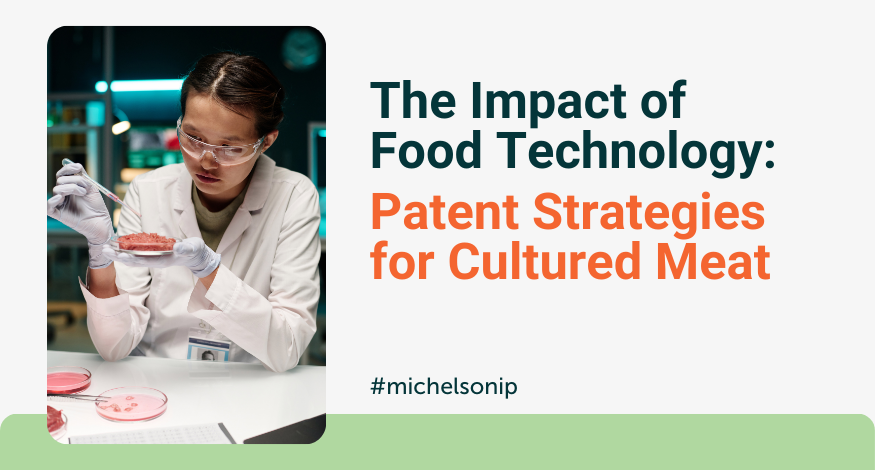Cultured meat is emerging as a groundbreaking development within the field of food technology. This growing industry, while still in its early stages, promises to address various global challenges, including food insecurity, environmental sustainability, and animal welfare. At the same time, it presents unique challenges and opportunities from an intellectual property (IP) perspective, particularly concerning patent strategies.
The Rise of Cultured Meat
Cultured meat, also known as lab-grown meat or cell-based meat, is produced by culturing animal cells in a controlled environment. This process eliminates the need for traditional animal farming, significantly reducing the environmental footprint and ethical concerns associated with meat production.
Not only does the rise of cultured meat offer exciting opportunities within the market as buyers seek to consume potentially healthier products with fewer environmental impacts, it also is built upon company-specific cell compositions and production techniques, to name a few. The complex biological process and individualized creation make cultured meat ripe for patent protection.
Biologics Patent Strategies
As cultured meat companies seek to protect their creations, the strategies employed in the biologics sector can serve as a blueprint.
Biologics, also known as biopharmaceuticals, are complex molecules produced from living organisms. In biologics, patents often cover a broad range of innovations, including specific processes and final products. Since both biologics and cultured meat involve similar complex biological processes and products, which are difficult to protect and require comprehensive patent coverage, the patent strategies in biologics serve as a prime example.
Cultured Meat Patent Opportunities
Cultured meat companies can secure patents for their unique methods of culturing cells and the final meat products. These patents can cover multiple aspects of the essential technology and its surrounding innovations, they include process, product, compositional, and equipment patents.
Process Patents protect the specific methods used to culture cells. This includes proprietary bioreactor designs that allow for optimal cell growth and unique nutrient media formulations, which provide the necessary environment for cell differentiation and growth. For example, patents might cover the use of specific growth factors or scaffolding materials that mimic the natural extracellular matrix.
Product Patents cover the unique characteristics of cultured meat, such as its texture, nutritional profile, and taste. Patents in this area may focus on the final composition of the meat product, including the specific cell types used (e.g., muscle cells, fat cells) and how these cells are combined to create a product that closely mimics traditional meat.
Compositional Patents can be used to protect combinations of ingredients used in the culturing process. Proprietary blends of amino acids, vitamins, and minerals that enhance cell growth and product consistency would be an example of a compositional patent. Additionally, patents might cover the use of novel biomaterials for scaffolds that support cell growth and contribute to the texture of the final product.
Equipment Patents may cover innovations in bioreactor technology, such as systems that allow for the large-scale production of cultured meat or devices that automate the monitoring and control of cell culture conditions. Innovations in equipment design can also include methods for harvesting and processing the cultured meat to ensure it meets safety and quality standards.
Patents vs. Trade Secrets
To date, many food companies have relied on trade secrets to protect their innovations. Trade secrets keep information hidden, though, which can make people more suspicious of new technologies, especially those involved in producing lab-generated foods. Patents, however, provide transparency—they require detailed descriptions of the scientific processes and innovations, allowing others to understand and evaluate them. This is likely to be critical to buyers looking to better understand what they are consuming.
Innovations in food technology tend to be met with scrutiny and skepticism, and cultured meat is no exception. Leveraging the openness of patents may help build trust and foster greater public confidence in cultured meat and other food technology advancements.
The Future of Food Patents
Patents in the food industry are here to stay, and their scope is expanding. Beyond protecting novel food products and processes, patents now cover a wide-range of innovations, not limited to packaging solutions, delivery mechanisms, and food safety technologies. These advancements cater to consumer demands for convenience and quality while addressing broader societal issues, such as hunger and malnutrition.
By using effective patent strategies, cultured meat companies can protect their innovations, encourage further advancements, and support a more sustainable and fair food system. As food technology evolves, it will play a key role in shaping our food supply, tackling global challenges, and enhancing quality of life.
The Michelson Institute for Intellectual Property, an initiative of the Michelson 20MM Foundation, provides access to empowering IP education for budding inventors and entrepreneurs. Michelson 20MM was founded thanks to the generous support of renowned spinal surgeon Dr. Gary K. Michelson and Alya Michelson. To learn more, visit 20mm.org.
